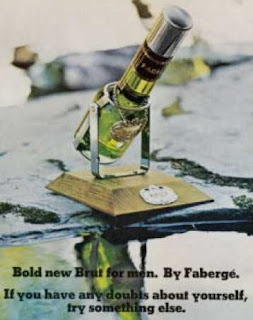In our previous post, we left off with the Fabergé family saga at the point where this storied name fell into the hands of the American entrepreneur Samuel Rubin to be used for his company’s perfume line. Beginning in the 1930s and through the Second World War, Rubin had always promoted the brand as up-market. After his $25,000 settlement with the sons of Carl Fabergé, which secured his rights to the name for his business (as well as the rights for future use for certain jewelry items), Rubin extended his Fabergé line to include cosmetics and toiletries that were available to consumers in department stores. Rubin created a brand that enjoyed a luxury reputation on par with other famous French names, Guerlain and Coty.
The business grew for more than a decade and in 1964 Rubin sold it for $26 million to George Barrie, who is in own right was twice nominated for the Academy Award Oscar. Barrie had founded mass-market beauty company Rayette, as well as developing a fragrance called Brut, which was to go on to become one of the most popular men’s cologne of all time. In 1964, firm was reincorporated to Rayette-Fabergé Inc.; then, in 1971, renamed Fabergé Inc.
But by this time, not only had the Faberge family lost the right to use its name, during the ensuing years it lost its own story and legacy. The American Faberge companies falsely adopted the history of Peter Carl Faberge and his Imperial Eggs for the Czars as its own, liberally using the magical appeal of the historic eggs and the romance of the Romanov Court as part of the brand identity, including the Royal Warrant awarded by Alexander III.
Barrie parlayed his Hollywood connection in molding Faberge into a mass marketing powerhouse. Legendary actor Cary Grant was hired in 1967 as a creative consultant to the firm and made appearances at sales conventions, as well as dropping by production facilities, during that year. In 1968 he was elevated to the company board and took on more responsibilities, although never doing outright endorsements or taking part in advertising. Part of Grant’s compensation package included an apartment in New York City, as the corporate headquarters was located there; and in line with his personal appearance role, an open travel budget plus free use of company’s planes and helicopters.
In 1970, actor Roger Moore of James Bond fame joined Grant on the board. That same year, Brut Productions was established as a wholly-owned subsidiary of Faberge Inc. and produced the film Touch of Class for which actress Glenda Jackson earned an Oscar in 1973. Television commercials for the Brut line starred NFL players Joe Namath, Paul Gascoigne and Kevin Keegan. Another series featured the fighters Henry Cooper and Mohamed Ali, while later spots had actress Kelly LeBrock (best known for her role in the 1984 film The Woman in Red).
With this solid celebrity advertising push and wide distribution through drug stores and other mass outlets, Brut sales rocketed to take the top spot as the best selling cologne in the world. Brut was joined by Babe in 1976 and that, too, became Fabergé's largest-selling women’s perfume. The late actress Margaux Hemingway (granddaughter of famed author Ernest Hemingway) signed for $1 million to promote Babe by Fabergé. Babe was honored with not one but two awards from the Fragrance Foundation: Most Successful Introduction of a Women's Fragrance in Popular Distribution and Best Advertising Campaign for Women's Fragrance.
Babe was followed in 1977 by the Farrah Fawcett hair care and fragrance lines with the Charlie’s Angels star inking a promotional contract with Fabergé. This led to one of the most sensational television ads of its era starring “Broadway Joe” Namath being shaved by the wildly popular sex-symbol Fawcett.
Barrie’s success continued and by 1984 the Fabergé Inc. portfolio of brands included fragrances Aphrodisia, Babe, Brut, Cavale, Farrah Fawcett, Flambeau, Just Wonderful, Kiku, Macho, Partage, Tigress, Woodhue, Xanadu and Zizanie. Personal care lines were Caryl Richards, Farrah Fawcett, Fabergé Organics, Aqua Net Hair Spray, Fabergé Ceramic Nail Glaze and Tip Top Accessories.
Thus, in this bizarre turn of events, the most famous name of the latter 19th Century – synonymous with opulence and unbridled luxury only attainable by royalty and the merely wealthy of Europe – became a staple of the corner drugstore.
Next post will reveal how the Fabergé tale ends in the US, moving yet again back to Europe.


The House of Faberge brand, Igor Faberge and the Franklin Mint are topics of a future post as well.
ReplyDeleteWhat a wonderful history lesson this is. I look forward to your next post
ReplyDeleteThe history of the family itself has all the makings of an old-time Bette Davis Hollywood movie -- more to come. Thanks for reading!
ReplyDelete